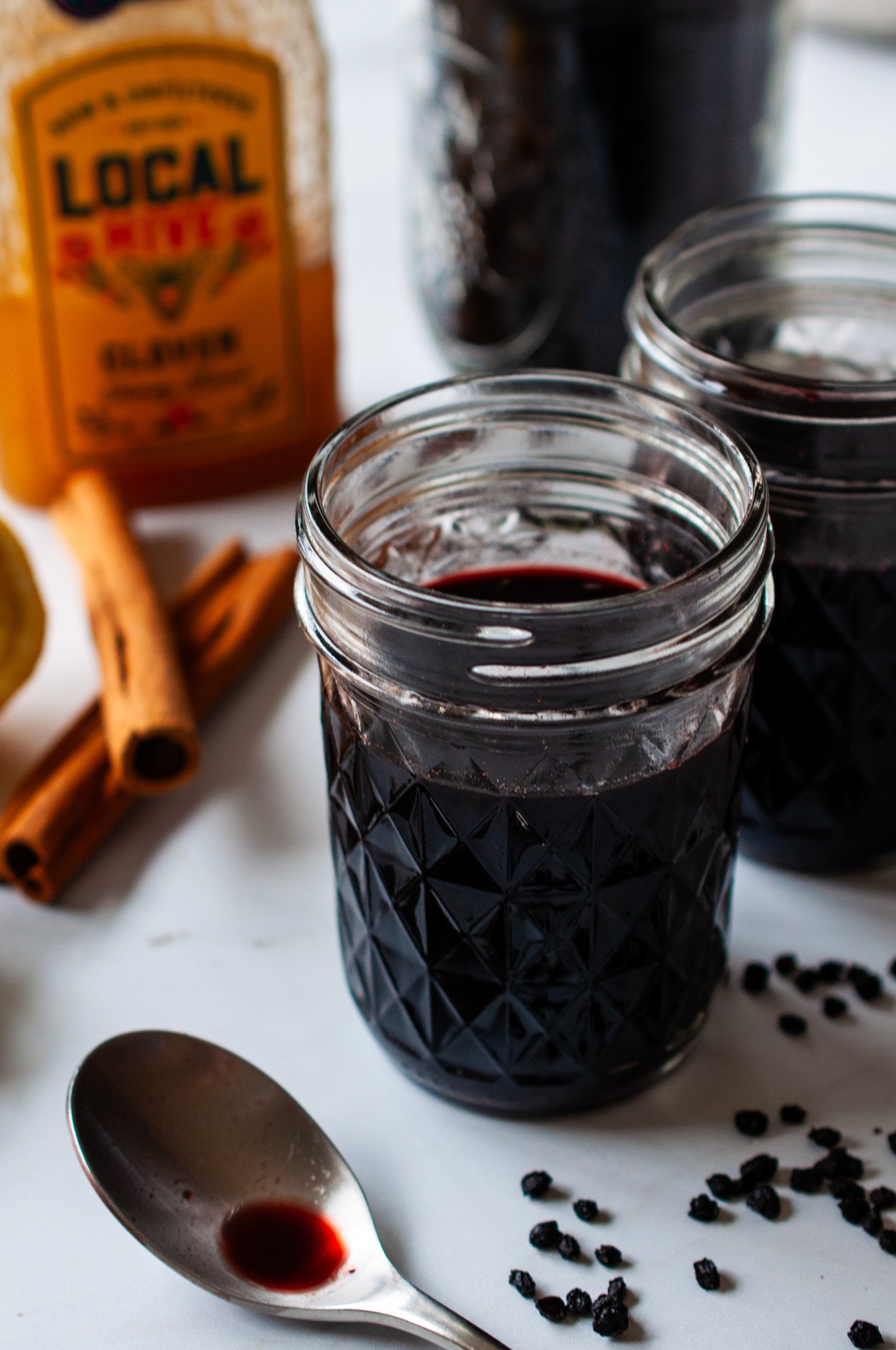Homemade Elderberry Syrup
Elderberry syrup provides concentrated immune-supporting benefits. It has a rich history use as a powerful cold preventative and remedy. It’s also a great source of antioxidants — which studies show it may protect your cells from damage, help prevent heart disease and even cancer. The sweet and slightly spicy syrup can also flavor a cup of winter tea or top a fruit dessert!
You can purchase dried berries or plant your own bushes. I purchased American Black seeds and European Black seeds from strictlymedicinalseeds.com for the woodline in my backyard.
When growing elderberries, keep in mind that they cross-pollinate. You will need to have at least two different varieties within 50 feet of each other for bearing quality fruit. The American elderberry (Sambucus Canadensis) produces small fruits that grow in clusters similar to grapes. The European Elderberry (Sambucus Nigra) which is more ornamental and does not produce as much fruit, nor is it as tasty. So mixing them together when making the syrup creates the best outcome. However, use caution if spotting elderberry in the wild: There is a related plant, the Red Elderberry (Sambucus Racemosa), that looks like other elderberries. It produces bright red fruits that are poisonous to humans. Elderberries are perennials and will start producing when they are 2-3 years old. Source.
What you'll need:
2/3 cup dried berries (or 1 cup fresh berries)
3 cups water
2-3 Ceylon cinnamon sticks (or 1 tsp ground Ceylon cinnamon)
1 tsp whole cloves (or 1/2 tsp ground cloves)
1-2 Tbsp fresh grated ginger (roughly peeled)
1 cup raw honey
1/2 tsp Celtic salt
1 tsp lemon juice
Organic ingredients are best for medicines, if you can swing it. Freeze the remaining fresh harvested elderberries in 1 cup portions for easy future use.
How to make it:
Pour water into a medium saucepan and add the elderberries, ginger, cinnamon, cloves, and pinch of Celtic salt.
(Ceylon cinnamon is a type of cinnamon that is more delicate and less pungent than cassia cinnamon. It has anti-inflammatory, cholesterol-lowering, and insulin-enhancing properties. Celtic salt is less processed and contains trace minerals like magnesium, calcium and potassium, great for increasing electrolytes within the body.)
Bring to a roiling boil, then reduce to a simmer over medium-low heat, uncovered, for about 30 minutes, stirring occasionally, until the liquid has reduced by almost half.
Remove from heat and let cool until it's lukewarm. Mash and muddle the berries carefully using a spatula or other flat utensil for a few minutes. Be careful not to splash, it stains!
Pour through a fine mesh strainer or cheesecloth into a glass mixing bowl, pressing all the juice out of the pulp. Discard the elderberry pulp.
When the liquid is no longer hot, add the cup of honey and squeeze of lemon, stir well. Pour or ladle the syrup into 2 smaller (sanitized) mason jars. This way, one jar will create a natural seal from the warm liquid and stay fresher longer, while you use up the first jar.
Store in the fridge and take daily for its immune boosting properties. Stored properly, elderberry syrup should stay fresh through the winter.
Instant Pot option: Put all the ingredients except honey in the Instant Pot. Seal the lid, and set manually for 9 minutes on high pressure. Vent pressure and strain. When cooled to room temperature stir in the honey.
Dosage:
Adult standard dose is ½ – 1 Tablespoon once a day.
Kids age 2+ standard dose is ½ – 1 teaspoon once a day. *Infants and children under 12 months are at the highest risk of developing botulism from honey.
If cold or flu symptoms are present, take the standard dose every 2-3 hours (up to 5 times a day total) until symptoms disappear.
Our family uses it as a preventative remedy during peak cold and flu season by taking ½ teaspoon as a daily supplement. If we get hit with a minor illness, we double-up until we feel better. Elderberry is commonly used for immune support and can be used year round as needed for its health benefits.
Important Cautions:
Collect only deep-blue/purple berry clusters that droop downward and grow from woody shrubs. Don’t collect berry clusters that grow upright, and don’t collect red elderberries.
Don’t eat raw elderberries; and don’t use the leaves, bark, or twigs (even though they have their uses under the care of experienced herbalists). Those parts can be toxic in consumption.
Because honey poses a risk of causing infant botulism, don’t give elderberry syrup to children younger than two years old.
If you’re pregnant or taking prescription medicines, don’t use elderberry tinctures or syrups without consulting your health professional first.
*I am not a medical professional. All of this information is based on personal experience and to be used at your own discretion. Discuss the use of elderberry with your doctor.


